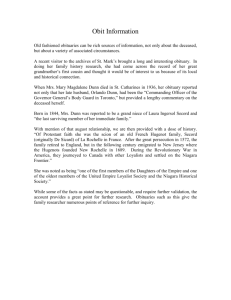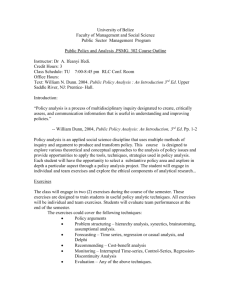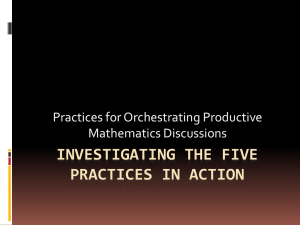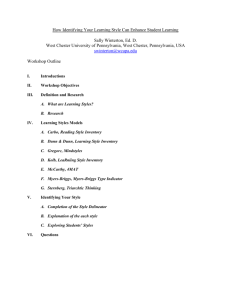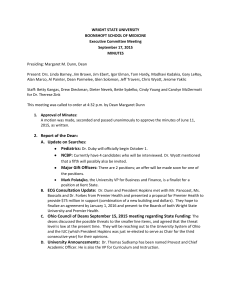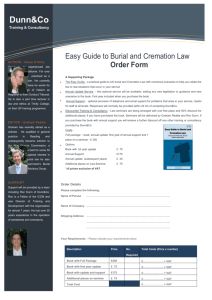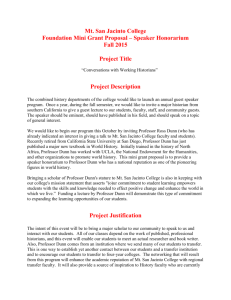Preferred Learning Styles and Its Effects On On
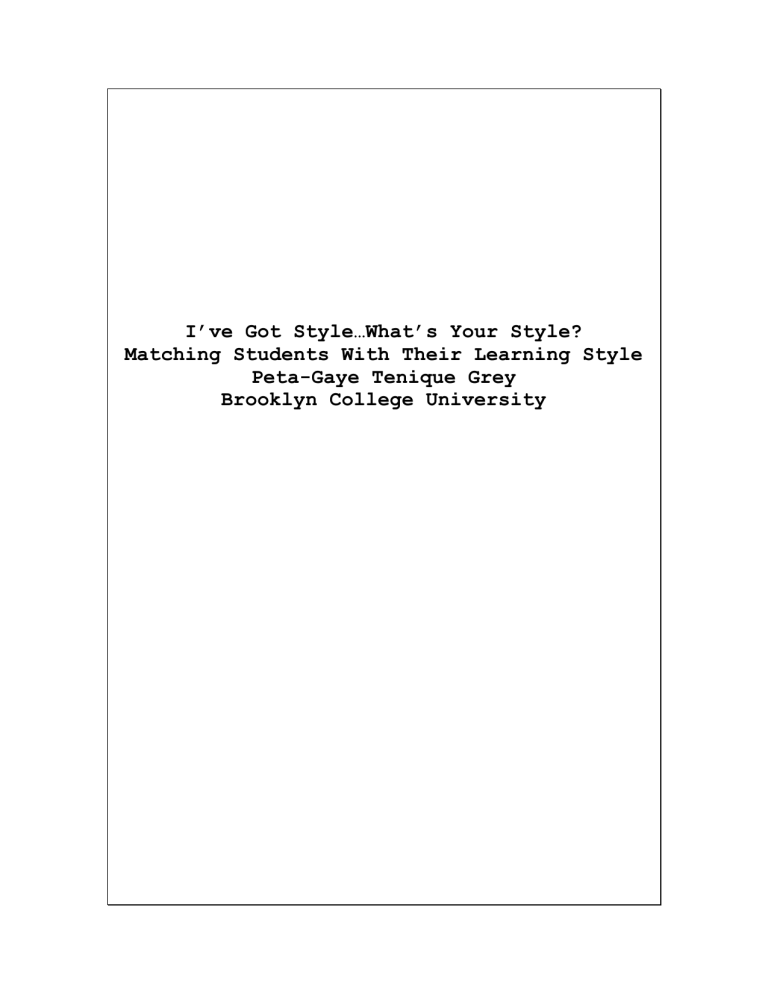
I’ve Got Style…What’s Your Style?
Matching Students With Their Learning Style
Peta-Gaye Tenique Grey
Brooklyn College University
Table of Contents
Abstract ii
Introduction 1
-Statement of the Problem 1
-Review of Related Literature 2-3
-Statement of the Hypothesis 4
Method 5
-Participants (N) 5
-Instrument(s)
-Experimental Design
-Procedure
Results
Discussion
Implications
References 6-7
Appendix (ces) 8-11
(Tables, Graphs, Questionnaires, Surveys, Texts etc.)
Abstract
Introduction
Classroom teachers and educators are aware that each student learns differently.
Through education classes and constant discussion, educators are aware that by identifying each student learning style, teaching to his or her learning style and implementing curriculum that compliments student learning can improve on-task behavior and increase content knowledge. The thought of identifying each student learning style may seem impossible and time consuming. However, with the right instrument, that is quick and effective, the process will be much more approachable.
A pressure has been placed on teachers to increase students’ grades on academic achievement test. We know that teaching to a students’ learning style will improve scores
(Dunn & Dunn, 1992). Rita and Kenneth Dunn created a Learning Style Model that is used worldwide. Research has proved the model is valid and reliable.
When teachers teach to students learning preference academic achievement increases, attitudes in learning increases and on-task behavior improves.
Statement of the Problem
Classroom teachers have the first hand experience to notice and identify problems or situations that need be addressed to improve student learning. It is our duty as pedadagogies to recognize issues that are affecting students learning and research how to implement a change. The purpose of this study was to investigate the effect of identifying students learning styles and the impact it has on the students’ on-task behavior.
What is Learning Style?
Everyone has a learning style. Our style of learning, if accommodated, can result in improved attitudes towards learning and an increase productivity, academic achievement, and creativity (Griggs, 1991).
The term “learning style has many definitions. For many years educational researchers have been curious about how individuals learn. Educators recognize that different students learn differently. Researchers have learned a great deal overt the last fifty years about learning styles and how identifying learning styles and teaching to those styles can improve students’ test scores and increase content knowledge (Pitts, 2002). Many researchers have their own definition of learning styles. Ausubel, Novak, & Hanesian
(1978) stated that “cognitive styles” or “learning styles” have been defined as “selfconsistent, enduring individual differences in cognitive organization and function” (as cited in Wilson, 1998, 2). Keefe (1982) defined learning styles as “cognitive, affective, and physiological traits that serve as relatively stable indicators of how learners perceive, interact with, and respond to the learning environment” (as cited in Wilson, 1998, 2), while Gregorc (1979) describes learning styles as “distinctive behaviors which serve as indicators of how a person learn from and adapts to his environment” (as cited in Wilson,
1998, 2). Dunn & Dunn (1992) defines learning style is the way in which individuals
begin to concentrate on, process, internalize and retain new and difficult academic information.
The Dunn and Dunn Learning Style Model
The Dunn and Dunn model was selected for the research of learning styles, because it is a multidimensional model with reliable and valid instrumentation and strong research base
(Griggs, 1991; Lovelace, 2005; Tendy & Geiser, 1997).
Rita and Kenneth Dunn have developed the Dunn and Dunn Learning Style Model over the last twenty-five years. Rita Dunn was a professor and Director of the Center for Study of Learning and Teaching Styles at St. Johns University, New York. Kenneth Dunn is a professor and coordinator of Administration and Supervision Programs at Queens
College, City University of New York. The model is “built on the theory that each individual has a unique set of biological and developmental characteristics. These unique characteristics impact substantially on how a person learns new information and skills.
Curry (1987) stated in a comparative analysis of the conceptualizations of learning styles and the psychometric standards of nine different instruments that purportedly measure learning-style preference, only the instrument designed to use with the Dunn and Dunn
Learning Style Model, the Learning Style Inventory (LSI), was rated as having good or better reliability and validity (as cited in Neely & Alm, 1992).
The Dunn and Dunn Learning-Style Model is based on the following assumptions
(Searson & Dunn, 2001):
1. Most individuals can learn.
2. Instructional environments, resources, and approaches respond to diversified learning style strengths.
3. Everyone has strengths, but different people have very different strengths.
4. Individual instructional preferences exist and can be measured reliably.
5. Given responsive environments, resources, and approaches, students attain statistically higher achievement and attitude test scores in matched, rather than mismatched treatments.
6. Most teachers can learn to use learning styles as a cornerstone of their instruction.
7. Many students can learn to capitalize on their learning style strengths when concentrating on new or difficult academic material. (Dunn & Dunn, 1993)
The Dunn and Dunn Learning Style Model includes twenty-two elements that, when classified, reveal which learners are affected by the following (Dunn & Dunn, 1992,
1993; Searson & Dunn, 2001):
Their immediate environment (sound, light, temperature, and furniture/seating designs)
Their own emotionality (motivation, persistence, responsibility
[conformity/nonconformity] and the need for either externally imposed structure or the opportunity to do things their own way)
Sociological preferences (learning alone, in a pair, in a small group, as part of a team, with an authoritative or collegial adult and wanting variety as opposed to patterns and routines)
Physiological characteristic (perceptual strengths, time-of day energy levels, and need for intake or mobility while learning)
Processing inclinations (global/analytic; right brain/left brain; impulsive/reflective)
No one person is affected by all the learning-style elements. Most people are affected by
6 to 14 elements (Dunn & Dunn, 1998).
Review of Literature-Pros
Although some students learn when instructions is provided through strategies that do not complement their learning styles, significantly higher standardized achievement test scores resulted among previously failing students when they were taught with strategies that complemented their learning-style preferences (Beglane, 2001; Burke & Dunn, 2002;
Dunn, Griggs, Olson, & Beasley, 1995; Lovelace, 2005). The reliability evidence and the validity evidence of the Dunn and Dunn model has had good results. A meta-analysis of forty-two experimental studies conducted with the Dunn and Dunn model between 1980 and 1990 by thirteen different institutions of higher education revealed that students whose characteristics were accommodated by education interventions responsive to their learning styles could be expected to achieve 75 percent of a standard deviation higher than students whose styles were not accommodated (Dunn et al. 1995; Shaughnessy,
1998). In an interviewed with Rita Dunn conducted by Michael Shaughnessy, Dunn commented, “practitioners throughout the United States have reported statistically higher test scores and /or grade point average for students whose teachers changed from traditional teaching to learning style teaching at all levels-elementary, secondary, and college. Improved achievement was often apparent after only six weeks of learning-style instruction. For example, prior to using learning styles, only 25 percent of the Frontier,
New York, school district’s special education high school students passes the required local examinations and state competency tests to receive diplomas. In the district’s first year of its learning styles program (1987-88) that number increased to 66 percent
(Shaughnessy, 1998). Lovelace (2005) conducted a Meta–analysis of experimental research on the Dunn and Dunn Model. The results indicated, on average, learning-style responsive instruction increased the achievement or improved the attitudes towards learning, or both, of all students. A North Carolina elementary school with a poverty level and minority population moved from the 30 th
percentile in reading and math on the
California Achievement Test to the 83 rd
percentile in three years. The only change at that school was the introduction of learning-styles instruction (Andrews, 1990; Shaughnessy,
1998). Lemmon (1985) stated “a school in Hutchinson, Kansas, reported that when students had flexibility in taking the Iowa Basic Skills Test at the time of day and in the seating arrangement that best matched their learning styles, they achieved higher mean gain scores in reading and math than they had achieved for the previous two years (as cited in Neely & Alm, 1992). A court order in Freeport, Illinois, mandated the Freeport
School District, to bring minority students up to the academic level of the majority. The
Dunn and Dunn Learning Style Model was implemented in the school district. As a
result, all students in Freeport’s learning style classes performed better on the standardized achievement tests when using their learning style (Burke & Dunn, 2002). In
Hodgin and Wooliscroft (1997) article, a teacher describes the use learning style to ensure that all students succeed in their inclusive classroom. By identifying a students’ learning style, the teacher was able to prevent a student from having an ADHD evaluation. In South Dakota, a Aberedeen school implemented the learning style model and reported that almost every teacher in the building has experienced exciting successes related to the implementation of learning styles (Neely & Alm, 1992). The successful implementation of the Dunn and Dunn Learning Styles model at Corsicana High School and Brightwood Elementary School led to an improvement in the climate and culture of the schools that resulted in increase academic achievement among students and a more positive school atmosphere that continued over many years (Beglane, 2001).
Review of Literature-Cons
The application of learning style theory encompasses three pervasive problems: confusion in definitions, weakness in measurement reliability and validity and identification of relevant learner characteristics (Curry, 1990). While it seems like a good idea to match teaching styles or methods of instruction to a student’s particular learning style, it is obvious from the different ideas of researchers that this could be problematic.
The type of teaching method would depend on the framework used to determine students’ learning styles. Additionally, some research has disputed the idea that learning styles are stable personality traits. They observe that learning style might best be described as situational, that is, depending on the particular situation in which the learning occurs.
Moreover, they argue that many of the self-report inventories fail to differentiate between learners ("Individual differences and learning styles", 2003). Coffield (2005) advises teachers to guard against the practice of pigeonholing students into narrowly defined categories. “Our research suggests labeling a pupil as, say a ‘visual’ learner may do more harm than good” (as cited in Ivie, 2009, 177). Ivie (2009) states “most of the supporting research cited by the Dunns comes from their own in-house studies of faculty who finished their doctoral work at St. John’s University. Few of this studies meet the standard of having been published in peer-reviewed journals.
Statement of the Hypothesis
All children can learn, but not all children learn in the same ways. Different children learn best in different ways and there is no one approach to instruction that fits all children. Integrating preferred learning styles over a six-week period to 22 kindergarten students at PS X during work-times will increase on-task behavior and increase content knowledge.
Method
Participants (N)
The present study was conducted with twenty-two kindergarten students in
Brooklyn, New York. The students are from an intact class from a school with middle-tohigh income families. The class is evenly divided: 11 boys and 11girls. Of all the students 65% were White, 30% were Black and 15% were Hispanic or Asian.
Instrument(s)
The Learning Style Inventory -Primary Version for children in kindergarten through grade two is a pictorial questionnaire. The Dunn and Dunn Learning Style Inventory
(LSI) for youth in grades 3-12 is a 104-item self -report questionnaire that identifies 22 elements relating to the environmental, emotional, sociological, physical, and psychological preferences of the individual.
Reference
Beck, C. R. (2001). Matching Teaching Strategies to Learning Style Preferences. Teacher
Educator, 37(1), 1-15.
Begalane, E. T. (2001). Principles Who Faced Obstacles to Learning Styles Instructions.
NASSP Bulletin, 85(627), 79-84. Doi: 10.1177/019263650108562709
Beliavsky, N. (2006). Revisiting Vygotsky and Gardner Realizing Human Potential
[Electronic version], Journal of Aesthetic Education, 40(2), 1-11.
Burke, K. & Dunn, Rita. (2002). Learning Style-Based Teaching to Raise Minority
Student Test Scores- There’s No Debate, Clearing House, 76(2), 103-106.
Carrier, S. J. (2009). Environmental Education in the Schoolyard: Learning Styles and
Gender [Electronic version]. The Journal of Environmental Education , 40 (3), 2-12.
Coffield, F. C. (2005). Kinaesthetic nonsense. Times Education Supplement, 14, 28-29.
Curry, L. (1990). A critique of the research on learning styles. Educational Leadership,
49, 50-52, 54-56.
DeBello, T. (1990). Comparison of eleven major learning styles models: Variables, appropriate populations, validity of instrumentation, and the research behind them.
Journal of Reading, Writing, and Learning Disabilities International, 6, 203-222.
Dunn, R. (1990). Rita Dunn answers questions on learning styles.
Educational
Leadership , 48(2), 15-19.
Dunn, R., & Dunn, K. (1992). Teaching elementary students through their individual learning style: Practical approaches for grades 3-6. Boston, MA: Allyn and Bacon.
(372.1394 DUN- Book)
Dunn, R., & Dunn, K. (1992). Teaching secondary students through their individual learning style: Practical approaches for grades 7-12. Boston, MA: Allyn and Bacon.
(373.1394 DUN- Book)
Dunn, R. (1996). 19 Easy-to-try Ways to Turn on Students. Teaching Pre K-8 , 27(3), 50-
51.
Dunn, R. (1998). Timing is Everything. Momentum, 29(4), 23-25.
Dunn, R., Denig, S., & Lovelace, M. K. (2001). Multiple Intelligences and Learning
Styles: Two Sides of the Same Coin or Different Strokes for Different Folks? Teacher
Librarian, 28(3).
Dunn, R., Griggs, S. A., Olson, J., & Beasley (1995). A Meta-Analytic Validation of the
Dunn and Dunn Model of Learning-Style Preferences. The Journal of Educational
Research, 88(6), 353-362.
Dunn, R., Honigsfeld, A., Doolan, L. S., Bostrom, L., Russo, K., Schiering, M. S., Suh,
B., & Tenedero, H. (2009). Impact of Learning-Style Instructional Strategies on Students’
Achievement and Attitudes: Perceptions of Educators in Diverse Institutions. A Journal of Educational Strategies, Issues and Ideas, 82(3), 135-140.
Duun, R., & Honigsfeld, A. (2006). WHAT IF CHILDREN WERE GROUPED FOR
READING WITH LEARNING-STYLE RESPONSIVE APPROACHES? Reading
Improvement, 43(2), 70-76.
Dunn, R., & Phi Delta Kappa Educational Foundation, B. (1995).
Strategies for
Educating Diverse Learners . Fastback 384. Retrieved from ERIC database
Griggs, S. A. (1991). Learning Styles Counseling. ERIC digest. ERIC Clearinghouse on
Counseling and Personnel Services. (ED 341 890- Microfiche- Digest in ERIC Database)
Honigsfeld, A. & Schiering, M. (2004). Diverse Approaches to the Diversity of Learning
Styles in Teacher Education, Educational Psychology, 24(4), 487-507.
Hodgin, J., & Wooliscroft, C. (1997). Eric Learns to Read: Learning Styles at Work.
Educational Leadership, 54(6), 43-45.
“Individual differences and learning styles." Retrieved from the Internet 5/5/2010 from http://www.cee.hw.ac.uk/~alison/ctl/ctl96/INDDIFF.html
Ivie, S. D. (2009). LEARNING STYLES: HUMPTY DUMPTY REVISITED. McGill
JOURNAL OF EDUCATION, 44(2), 177-192.
Lovelace, M. K. (2005). Meta-Analysis of Experimental Research Based on the Dunn and Dunn Model. Journal of Educational Research, 98(3), 176-183.
Neely, R. O., & Alm, D. (1992). Meeting Individual Needs: A Learning Style Success
Story. Clearing House, 66(2), 109-113.
Searson, R. & Dunn, R. (2001). The Learning-Style Teaching Model. Science and
Children, 38(5), 22-26.
Shaughnessy, M. F. (1998). AN INTERVIEW WITH RITA DUNN ABOUT
LEARNING STYLES. Clearing House , 71(3), 141-145.
Tendy, S., & Geiser, W. (1997). The search for Style: It All Depends on Where You
Look. Retrieved from ERIC database
Terregrossa, R., Englander, F., & Englander, V. (2009). The Impact of Learning Styles on Achievement in Principles of Microeconomics: A Natural Experiment.
College
Student Journal, 43(2), 400-410.
Wilson, V. (1998). Learning How They Learn: A Review of the Literature on Learning
Styles. Retrieved from ERIC database
Appendix A
Appendix B
Initial Teacher Observation Checklist by Linda Loken Emery
SOUND
- - - - does quality work during quiet work time
- - - - does quality work during regular work time
- - - - does quality work during work time with music in background
- - - - complains when there is too much sound present
- - - - makes sounds or noises while working
- - - - reminds others to be quiet while working
DESIGN
- - - - has difficulty sitting in position in circle-time arrangement
- - - -enjoys lying down while watching television or listening to stories
- - - - sits in chair correctly during work-time periods
- - - stands by work area at table during work-time periods
RESPONSIBILITY AND PERSISTENCE
- - - - quickly and neatly completes projects
- - - - quickly but not neatly completes projects
- - - - slowly and neatly completes projects
- - - - sometimes does not complete projects
- - - - works best when given specific instructions
- - - - independently cleans up work area upon completion of task
- - - - needs to be reminded to clean up work area upon completion of task
- - - - easily distracted while working on a project
- - - -remembers homework assignments
MOBILITY
- - - - is frequently out of chair during work periods
- - - - often requests a drink of water or gets a tissue just to be able to move about the classroom
- - - - is extremely active during free-play periods
MOTIVATION
- - - - works best with much assurance from others
- - - - need teacher feedback while working
- - - - does projects on own accord
- - - - volunteer’s information about past experiences with discussion topics
PERCEPTION
- - - - enjoys looking at books, filmstrips, and television
- - - - sits up from and is attentive during work time
- - - - likes to listen to records or tapes during work time
- - - - remembers well what others say
- - - - likes to visit
- - - - enjoys playing with toys with small pieces
- - - - likes to draw or doodle
- - - enjoys physically moving around during work or play
- - - - likes to create play situations and react to them
Appendix C
Peta-Gaye T. Grey
Brooklyn Friends School
375 Pearl Street
Brooklyn, NY 11201
718-852-1029
Dear Class X Parents,
In addition to being a teacher at Brooklyn Friends
School, I am also a student in the Brooklyn College Masters of Education Program. As part of the program, I will be conducting a research study to learn more the effect of identifying a students learning style and their academic achievement. The audience of this study is teachers, researchers and education practitioners. I would appreciate your permission to have your child be a part of this study.
The study would require me to identify your child preferred learning style by doing a questionnaire and observation.
Identifying your child’s learning style will help me to teach he/she the way they learn best which will increase academic achievement.
Your child’s name will not appear in the study. Two copies of this request are enclosed. Please sign both copies and return on to me, keeping the other one for your files.
Thank you for your consideration.
Sincerely,
Peta-Gaye T. Grey
I give permission for my child __________________________ to participate in your Action Research. I understand that he/she name will not appear in the study.
Date _______________________
Parent
Signature _______________________
